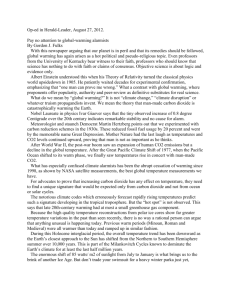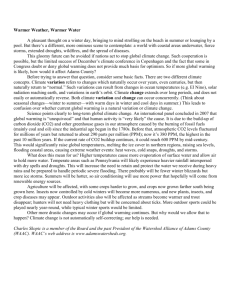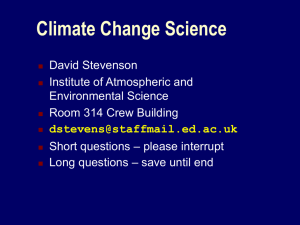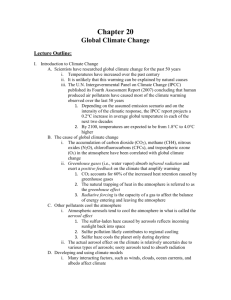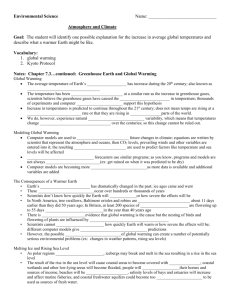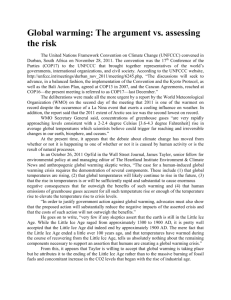Chapter 16
advertisement
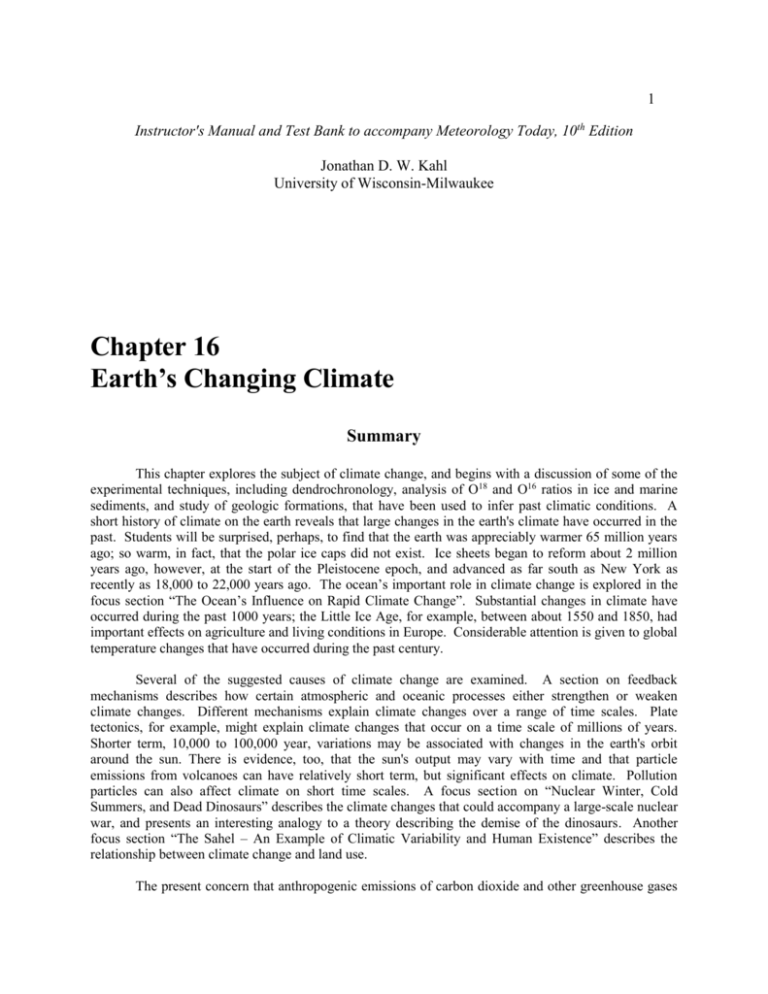
1 Instructor's Manual and Test Bank to accompany Meteorology Today, 10th Edition Jonathan D. W. Kahl University of Wisconsin-Milwaukee Chapter 16 Earth’s Changing Climate Summary This chapter explores the subject of climate change, and begins with a discussion of some of the experimental techniques, including dendrochronology, analysis of O18 and O16 ratios in ice and marine sediments, and study of geologic formations, that have been used to infer past climatic conditions. A short history of climate on the earth reveals that large changes in the earth's climate have occurred in the past. Students will be surprised, perhaps, to find that the earth was appreciably warmer 65 million years ago; so warm, in fact, that the polar ice caps did not exist. Ice sheets began to reform about 2 million years ago, however, at the start of the Pleistocene epoch, and advanced as far south as New York as recently as 18,000 to 22,000 years ago. The ocean’s important role in climate change is explored in the focus section “The Ocean’s Influence on Rapid Climate Change”. Substantial changes in climate have occurred during the past 1000 years; the Little Ice Age, for example, between about 1550 and 1850, had important effects on agriculture and living conditions in Europe. Considerable attention is given to global temperature changes that have occurred during the past century. Several of the suggested causes of climate change are examined. A section on feedback mechanisms describes how certain atmospheric and oceanic processes either strengthen or weaken climate changes. Different mechanisms explain climate changes over a range of time scales. Plate tectonics, for example, might explain climate changes that occur on a time scale of millions of years. Shorter term, 10,000 to 100,000 year, variations may be associated with changes in the earth's orbit around the sun. There is evidence, too, that the sun's output may vary with time and that particle emissions from volcanoes can have relatively short term, but significant effects on climate. Pollution particles can also affect climate on short time scales. A focus section on “Nuclear Winter, Cold Summers, and Dead Dinosaurs” describes the climate changes that could accompany a large-scale nuclear war, and presents an interesting analogy to a theory describing the demise of the dinosaurs. Another focus section “The Sahel – An Example of Climatic Variability and Human Existence” describes the relationship between climate change and land use. The present concern that anthropogenic emissions of carbon dioxide and other greenhouse gases 2 may be causing global warming is carefully examined. While there seems to have been a small increase in global average temperatures during the past century, we see that, because the response of the oceans to warmer temperatures and increasing CO2 amounts and the effects of clouds and aerosols are not well understood, there are large uncertainties in the computer model predictions of future changes. Focus sections on “The Extremes of 2011: Did Climate Change Play a Role?” and “Climate Models – A quick Glance” provide details. Projections of future climate changes based on the Intergovernmental Panel on Climate Change (IPCC) 2007 report are presented. Uncertainties in the predictions are discussed, as are some of the effects that future changes in surface temperatures might have. The chapter concludes with a discussion of efforts to reduce global warming. Teaching Suggestions 1. Climate change is an area of active research at present and receives a lot of coverage on television, in newspapers, and in popular magazines. Use current news or articles to motivate or stimulate discussion in class. 2. Bring in a guest speaker who will describe their research and how it relates to climate change. 3. Examine long-term temperature and precipitation changes at several cities of the students’ choice, using the National Climatic Data Center’s “CLIMVIS” (Climate Visualization) web site, www.ncdc.noaa.gov/onlineprod/drought/xmgr.html. Do these trends present evidence of global warming? Of cooling? 4. Invite students to describe their personal observations of climate change. (Did it snow more when they were younger? Were summers cooler then?) Discuss possible relationships these observations and global climate change. 5. Compare Figures 16.8 and 16.6. What are some reasons to believe that the recent climate changes are not just short-term fluctuations that may reverse themselves? 6. Invite a speaker from your university’s Geology or Geoscience department to speak about plate tectonics and it’s relation to climate change. 7. Ask students if they’re aware of land-use changes in the local area. How might these changes influence the local climate? 8. Initiate a discussion on the confidence the public should place on predictions of future climate. 9. Conduct a classroom debate on whether affluent countries should finance poor countries’ efforts to reduce greenhouse gas emissions. 10. Discuss the ironies regarding the cooling effect of sulfate aerosol pollution. 3 Student Projects 1. Have students obtain climatological data (mean temperature and precipitation amounts), from their city or a city nearby, for as long a period of time as possible. Are there any noticeable periodic variations or long-term trends? Can any observed fluctuations be correlated with recent volcanic eruptions, strong ENSO events, or the sunspot cycle? Where were the weather data obtained? Has urbanization had any effect on the weather data? 2. It might be possible to obtain a section from a recently cut tree. Then, if a date can be accurately identified with one of the growth rings, try to determine whether the width of the rings is correlated with past mean annual temperatures or yearly rainfall amounts. 3. Using a book that describes the local geology, have the students prepare a report on the past climate in their region. If possible, photograph or obtain samples from geological structures that were used to infer past conditions. 4. Have students read and discuss the 2007 IPCC “Summary for Policymakers” report (http://www.ipcc.ch/pdf/assessment-report/ar4/syr/ar4_syr_spm.pdf) and discuss the merits of reducing global emissions of greenhouse gases. 5. According to the future climate model projections in the 2007 IPCC “Summary for Policymakers” report (http://www.ipcc.ch/pdf/assessment-report/ar4/syr/ar4_syr_spm.pdf), is the term “Global Warming” appropriate? Which areas of the globe are projected to warm the most? Are there areas that are expected to cool? Answers to Questions for Review 1. The study of the geological evidence left behind by advancing and retreating glaciers; collection of fossil pollen of tundra plants; core samples taken from ocean floor sediments and Greenland and Antarctica ice; the study of annual growth rings of trees; documents concerning droughts, floods, and crop yields; the study of oxygen-isotope ratios of corals; borehole temperature profiles. 2. The most recent North American glaciers reached their maximum thickness and extent about 18,000 to 22,000 years ago. At that time, the sea level was perhaps 120 m (395 ft) lower than it is now. The lower sea level exposed vast areas of land, such as the Bering land bridge, a strip of land that connected Siberia to Alaska, which allowed human and animal migration from Asia to North America. 3. It is significantly higher. 4. The Younger-Dryas was a cold spell lasting from about 12,700 to 11,700 years ago. 5. A positive feedback mechanism is a process which is reinforced by other processes. A negative feedback mechanism is a process which is weakened by interactions among other variables. The water vapor-temperature increase process is a positive feedback mechanism. 6. Chemical weathering is a process by which carbon dioxide is removed from the atmosphere as silicate minerals in rocks decompose in the presence of moisture. In this feedback, as chemical weather 4 increases, the amount of CO2 in the atmosphere decreases. The reason for this situation is that chemical weathering (and the removal of CO2 from the atmosphere) will generally take place more rapidly on a warmer planet, as chemical reactions speed up and greater evaporation from the oceans leads to more precipitation over the continents. As CO leaves the atmosphere more quickly, CO2 levels drop and earth’s climate begins to cool and stabilize. As temperatures dip, less water evaporates from the oceans, chemical weathering decreases, and the removal of CO2 from the atmosphere diminishes. 7. According to plate tectonics, the now existing continents were at one time joined together in a single huge continent, which broke apart. Its pieces slowly moved across the face of the earth, thus changing the distribution of continents and ocean basins. We find glacial features near sea level in Africa today, suggesting that the area underwent a period of glaciation hundreds of millions of years ago. Were temperatures at low elevations near the equator ever cold enough to produce ice sheets? Probably not. The ice sheets formed when this land mass was located at a much higher latitude. Over the many millions of years since then, the land has slowly moved to its present position. Along the same line, we can see how the fossil remains of tropical vegetation can be found under layers of ice in polar regions today. 8. The first cycle deals with changes in the shape (eccentricity) of the earth’s orbit as the earth revolves about the sun. To go from less elliptical to more elliptical and back again takes about 100,000 years. The greater the eccentricity of the orbit (that is, the more eccentric the orbit), the greater the variation in solar energy received by the earth between its closest and farthest approach to the sun. The second cycle takes into account the fact that, as the earth rotates on its axis, it wobbles like a spinning top. This wobble, known as the precession of the earth’s axis, occurs in a cycle of about 23,000 years. This affects the strength of seasonal variations in climate. The third cycle takes about 41,000 years to complete and relates to the changes in tilt (obliquity) of the earth as it orbits the sun. Presently, the earth’s orbital tilt is 23.5°, but during the 41,000-year cycle the tilt varies from about 22° to 24.5°. The smaller the tilt, the less seasonal variation there is between summer and winter in middle and high latitudes. Thus, winters tend to be milder and summers cooler. During the warmer winters, more snow would probably fall in polar regions due to the air’s increased capacity for water vapor. And during the cooler summers, less snow would melt. As a consequence, the periods of smaller tilt would tend to promote the formation of glaciers in high latitudes. 9. Lower. 10. Sulfate aerosols reflect incoming sunlight, which tends to lower the earth’s surface temperature during the day. Sulfate aerosols may also modify clouds by increasing their reflectivity. 11. A nuclear war would raise an enormous pall of thick, sooty smoke from massive fires that would burn for days, even weeks, following an attack. The smoke would drift higher into the atmosphere, where it would be caught in the upperlevel westerlies and circle the middle latitudes of the Northern Hemisphere. For several weeks after the war, sunlight would virtually be unable to penetrate the smoke layer, bringing darkness or, at best, twilight at midday. Such reduction in solar energy would cause surface air temperatures over landmasses to drop below freezing, even during the summer, resulting in extensive damage to plants and crops and the death of millions (or perhaps billions) of people. The dark, cold, and gloomy conditions that would be brought on by nuclear war are often referred to as nuclear winter. As the lower troposphere cools, the solar energy absorbed by the smoke particles in the upper troposphere would cause this region to warm. The end result would be a strong, stable temperature inversion extending from the surface up into the higher atmosphere. 5 12. They tend to cool the surface, because the particles are very small and are injected to high altitudes where they quickly encircle the globe and scatter large amounts of sunlight. 13. Sunspots, huge magnetic storms on the sun, occur in cycles, with the number and size reaching a maximum approximately every 11 years. During periods of maximum sunspots, the sun emits more energy (about 0.1 percent more) than during periods of sunspot minimums. Evidently, the greater number of bright areas (faculae) around the sunspots radiate more energy, which offsets the effect of the dark spots. Some researchers argue that periodic 20-year droughts on the Great Plains of the United States seem to correlate with the 22-year cycle in the sun's magnetic output. 14. Water vapor. 15. Water vapor, via the water vapor-greenhouse effect feedback; solar irradiance changes; volcanic eruptions rich in sulfur. 16. Changes in incoming solar radiation, changes in the composition of the atmosphere, changes in the earth’s surface, water vapor-greenhouse feedback, snow-albedo feedback. 17. Aerosols injected into the atmosphere, increasing levels of greenhouse gases, land use changes. 18. Clouds reflect incoming sunlight back to space, a process that tends to cool the climate, but they also absorb infrared radiation from the earth, which tends to warm it. b. High clouds promote warming, low clouds promote cooling. 19. The actual rise in surface temperature is affected by both natural and anthropogenic forcing agents. 20. Because evidence from climate models and past temperature histories support the idea that the recent warming is largely due to greenhouse gases. 21. Climate models predict that land areas will warm more rapidly than the global average, particularly in the northern high latitudes in winter. If warming allows the boreal forests to expand into the tundra, the forests may accelerate the warming in that region. As the temperature rises, organic matter in the soil should decompose at a faster rate, adding more CO2 to the air, which might accelerate the warming even more. In a warmer world, enhanced evaporation of water should lead to greater worldwide average precipitation. Some models predict that the jet stream will weaken and global winds will shift from their “normal” position. The shifting upper-level winds might reduce precipitation over certain areas, which, in turn, would put added stress on certain agricultural regions. 22. No – other important greenhouse gases are methane, nitric oxide, halocarbons and ozone. 23. The conveyor-like circulation begins in the north Atlantic near Greenland and Iceland, where salty surface water is cooled through contact with cold Arctic air masses. The cold, dense water sinks and flows southward through the deep Atlantic Ocean, around Africa, and into the Indian and Pacific Oceans. In the North Atlantic, the sinking of cold water draws warm water northward from lower latitudes. As this water flows northward, evaporation increases the water’s salinity (dissolved salt content) and density. When this salty, dense water reaches the far regions of the North Atlantic, it gradually sinks to great depths. This warm part of the conveyor delivers an incredible amount of tropical heat to the northern Atlantic. During the winter, this heat is transferred to the overlying atmosphere, and evaporation 6 moistens the air. Strong westerly winds then carry this warmth and moisture into northern and western Europe, where it causes winters to be much warmer and wetter than one would normally expect for this latitude. Answers to Questions for Thought 1. The chemical concentrations retrieved from the water and air bubbles within ice cores may have undergone a variety post-depositional processes which can complicate their interpretation. These processes include chemical reactions, blowing and drifting, wind pumping (horizontal movement within the snowpack), freezing and thawing, and folding associated with subsurface glacial movement. 2. Because of the lower temperatures (in the Northern Hemisphere), precipitation was probably less than at present. 3. The effect of an increase in global cloudiness would probably depend upon the type and height of clouds that form. High, thin cirriform clouds would probably promote global warming (positive feedback) by allowing much of the incident sunlight to pass through them. At the same time, these cold clouds would radiate back to earth more infrared radiation than they would emit to space. Low stratified clouds would probably cool the planet (negative feedback) by reflecting much of the incident sunlight back to space. Also, their warm tops would radiate away much of the infrared energy that they receive from the earth. 4. Sulfate aerosols may scatter incident sunlight back into space. Sulfate aerosols may also serve as cloud condensation nuclei and thereby modify clouds. With high condensation nuclei concentrations, clouds are composed of a larger number of smaller droplets and are more reflective. 5. In the Northern Hemisphere ice ages are more likely when the tilt of the earth is at a minimum. During this time, summers would be cooler and less snow would melt. For winter snow to fall, temperatures need only be at freezing or below. In fact, during the slightly warmer winter, more snow may actually fall (often there is a reduction in snow fall during very cold winters). By the same reasoning, ice ages are more likely when the sun is closest to the Northern Hemisphere during the winter. 6. Warmer poles would decrease the equator-to-pole temperature gradient, thereby reducing the strength of midlatitude winter storms. 7. If the oceans remove less CO2 from the atmosphere, then atmospheric concentrations of CO2 could be expected to increase. This could cause the earth to warm further. 8. For snow to fall, the surface air temperature need only be near freezing. In fact, the heaviest snows generally occur when the air temperature is only slightly below freezing. The main factor in keeping the snow on the ground for an entire year is the air temperature in summer. Cooler summers, of course, produce less melting and a greater likelihood that the snow will exist (in certain areas) for a long time. Once the snow stays on the ground it produces even cooler summers by reflecting much of the sunlight that strikes the region. 7 Answers to Critical Thinking Questions Figure 16.3. About 150 meters. Figure 16.19. The project warming would be somewhat greater. 8 Multiple Choice Exam Questions 1. If the average snowfall over an area of north central Canada is 100 cm per year, how long would it take for the snow to reach a depth of 1,000 meters? (Assume that there is no melting in summer and no compaction.) a. 10 years b. 1,000 years c. 10,000 years d. 100,000 years e. 10,000,000 years ANSWER: B 2. Ice cores record both the record of past temperatures and the causes of climate change. a. true b. false ANSWER: A 3. The higher the ratio of oxygen 18 to oxygen 16 in the shells of organisms that lived in the sea during the geologic past, the ____ the climate at that time. a. colder b. warmer c. wetter d. drier ANSWER: A 4. Which of the following is not true? a. Oxygen 16 evaporates more readily from the ocean than oxygen 18. b. Oxygen 16 and oxygen 18 are found in roughly equal amounts in ocean water. c. The nucleus of oxygen 18 contains two more neutrons than the nucleus of oxygen 16. d. Both oxygen 16 and oxygen 18 are found in the shells of marine organisms. ANSWER: B 5. A high concentration of oxygen 16 found in the ice caves of Antarctica and Greenland would indicate ____ at the time the ice was formed. a. cold air temperatures b. mild winters c. intense ultraviolet radiation d. the caves were under the ocean ANSWER: A 6. Indications of past climates in tree rings are determined by examination of the: a. thickness of growth rings. b. density of growth rings. 9 c. presence of frost rings. d. both thickness and density of growth rings. e. all of the above ANSWER: E 7. Evidence suggests that throughout much of the earth's history, the global climate was a. warmer than it is today. b. colder than it is today. c. about the same temperature as it is today. d. more variable than it is today. ANSWER: A 8. Which of the following has been used to reconstruct past climates? a. analysis of air bubbles trapped in ice b. study of documents describing floods, droughts and crop yields c. the ratio of oxygen 18 to oxygen 16 in the shells of marine organisms d. study of geologic formations e. all of the above ANSWER: E 9. Presently glaciers cover ____ of the earth's surface. a. about 10 percent b. less than 1 percent c. approximately two thirds d. none ANSWER: A 10. Thick sheets of ice advanced over North America as far south as New York as recently as a. 1816 ("the year without a summer"). b. 1550. c. 18,000 to 22,000 years ago. d. 2 million years ago, at the beginning of the Pleistocene epoch. ANSWER: C 11. Over the past 100 years or so, it appears that average global temperatures have a. increased slightly. b. fluctuated widely but shown no overall change. c. decreased slightly. d. remained constant. ANSWER: A 12. The Viking colony in Greenland perished during a. the Pleistocene epoch. 10 b. the climatic optimum. c. the Little Ice Age. d. the explosion of Mount Pinatubo. ANSWER: C 13. During the Little Ice Age, a. the climatic optimum occurred. b. the Bering land bridge formed. c. alpine glaciers grew in size and advanced. d. continental glaciers covered large portions of North America. e. sea level lowered by about 280 feet. ANSWER: C 14. The "year without a summer" (1816) may have been caused by a. soot from coal fires. b. particulate matter and gases from volcanoes. c. a dust cloud produced when a meteorite collided with the earth. d. deforestation. ANSWER: B 15. If the earth were in a cooling trend, which process below would most likely act as a positive feedback mechanism? a. increasing the snow cover around the earth b. increasing the water vapor content of the air c. decreasing the amount of cloud cover around the globe d. increasing the carbon dioxide content of the air ANSWER: A 16. If the earth were in a warming trend, which of the processes below would most likely act as a negative feedback mechanism? a. increasing the water vapor content of the air b. increasing the snow cover around the earth c. decreasing the amount of cloud cover around the globe d. increasing the carbon dioxide content of the air ANSWER: B 17. A positive feedback mechanism a. acts to reinforce an initial change. b. acts to weaken or oppose an initial change. c. will cause a positive change. d. will cause a negative change. ANSWER: B 11 18. Which theory explains how glacial material can be observed today near sea level at the equator, even though sea level glaciers probably never existed there? a. Milankovitch theory b. Theory of plate tectonics c. Volcanic dust theory d. Maunder theory ANSWER: B 19. to Plate tectonics "explains" certain climatic changes by showing that these changes may be related a. b. c. d. e. mountain building. the amount of CO2 and H2O released into the atmosphere. the paths taken by ocean currents. the position of the continents. all of the above ANSWER: E 20. The Milankovitch Theory proposes that climatic changes are due to a. variations in the earth's orbit as it travels through space. b. volcanic eruptions. c. changing levels of CO2 in the earth's atmosphere. d. particles suspended in the earth's atmosphere. ANSWER: A 21. During a period when the earth's orbital tilt is at a minimum, which would probably not be true? a. There should be less seasonal variation between summer and winter. b. More snow would probably fall during the winter in polar regions. c. There would be a lesser likelihood of glaciers at high latitudes. d. There would be less seasonal variations at middle latitudes. ANSWER: C 22. Precession of the equinox refers to a. changes in the shape of the earth's orbit as the earth revolves around the sun. b. changes in the tilt of the earth as it orbits the sun. c. changes in the seasons, especially from winter to summer. d. the wobble of the earth on its axis. ANSWER: D 23. The Milankovitch cycles in association with other natural factors explain how glaciers may advance and retreat over periods of a. hundreds of millions of years. b. several million years. c. hundreds of thousands of years. d. ten thousand years to one hundred thousand years. 12 e. hundreds of years. ANSWER: D 24. The formation of continental glaciers over vast areas of North America is most favorable when Northern Hemisphere summers are ____ and winters are ____. a. cool, extremely cold b. cool, mild c. warm, extremely cold d. warm, mild ANSWER: B 25. Volcanoes that have the most impact on global climate seem to be those rich in a. nitrogen. b. water vapor. c. carbon dioxide. d. sulfur. e. oxygen. ANSWER: D 26. Large volcanic eruptions with an ash veil that enters the stratosphere tend to ____ at the surface. a. increase temperatures b. increase precipitation c. decrease temperatures d. have no effect ANSWER: C 27. The quasi-biennial oscillation is a pattern of a. ice advances and retreats spanning 2 million years. b. 22 year-long sunspot cycles. c. reversing stratospheric winds above the tropics. d. increases and decreases in carbon dioxide concentrations. e. solar activity that takes about 2 years to complete its cycle. ANSWER: C 28. It now appears that if global temperatures continue to rise, the oceans a. will increase the amount of CO2 in the atmosphere. b. will reduce the amount of CO2 in the atmosphere. c. could increase or reduce the amount of CO2 in the atmosphere. d. will have no effect on atmospheric CO2 concentrations. ANSWER: C 29. It appears that, as the number of sunspots increases, the sun's total energy output a. increases slightly. 13 b. decreases slightly. c. begins to alternately increase and decrease above average values. d. does not change. ANSWER: A 30. The Maunder Minimum refers to a time when a. the earth was in the middle of an ice age. b. the tilt of the earth's axis was less than it is now. c. the earth was closer to the sun than it is now. d. few snowstorms occurred over the United States. e. there were fewer sunspots on the sun. ANSWER: E 31. Studies reveal that during colder glacial periods, CO2 levels ____ during warmer interglacial periods. a. were higher than b. were lower than c. were about the same as d. were more variable than ANSWER: B 32. For CO2 concentration of this gas must also increase in the atmosphere: a. chlorofluorocarbons (CFCs) b. nitrous oxide (N2O) c. water vapor (H2O) d. ozone (O3) ANSWER: C 33. An increase in atmospheric CO2 concentrations will most likely lead to ____ in the troposphere and ____ in the upper atmosphere. a. warming, warming b. cooling, warming c. warming, cooling d. cooling, cooling ANSWER: C 34. It is now known that, overall, clouds a. have a net warming effect on climate. b. have a net cooling effect on climate. c. have no net effect on climate. d. are the single most important feature in determining climate. ANSWER: B 14 35. The most recent warming trend experienced over the Northern Hemisphere could be the result of a. increasing volcanic eruptions. b. light-colored particles in the stratosphere. c. increasing levels of CO2. d. a decrease in the energy emitted by the sun. e. an observed decrease in snow cover. ANSWER: C 36. Everything else being equal, a gradual increase in global CO2 would most likely bring about a. an increase in surface air temperature. b. a marked decrease in plant growth. c. a decrease in evaporation from the earth's oceans. d. no change in global climate. ANSWER: A 37. Which of the conditions below would most likely produce warming at the earth's surface? a. increase the amount of low-level global cloudiness b. increase the amount of sulfur-rich particles in the stratosphere c. decrease the energy output of the sun d. increase the amount of global snow cover e. increase the amount of high-level global cloud cover ANSWER: E 38. Which below is not one of the possible consequences of global warming predicted by climate models? a. accumulations of additional snow in Antarctica b. a reduction in average precipitation over certain areas c. lowering of sea levels d. a cooling of the upper atmosphere e. a drop in the rate of ozone destruction in the stratosphere ANSWER: C 39. The much-studied temperature record of the past 140 years is derived from a. land-based observations only. b. oceanic observations only. c. both land-based and oceanic observations. ANSWER: C 40. A biogeophysical feedback mechanism in the Sahel relates a. reduced cloud cover to increasing surface temperatures and an increase in rainfall. b. reduced vegetation to a decrease in surface temperatures and a reduction in rainfall. c. an increase in vegetation to an increase in surface temperatures and a reduction in rainfall. d. a decrease in vegetation to a lowering of surface albedo and an increase in rainfall. 15 ANSWER: B 41. A significant percentage of the observations comprising the much-studied temperature record of the past 140 years were not air temperatures, but rather were temperatures of ocean surface waters. a. true b. false ANSWER: A 42. The ocean's conveyor belt circulation is controlled by a. gradients in temperature. b. gradients in salinity. c. gradients in density. d. all of the above ANSWER: D 43. The warming trend that began in the 1970s a. extended to the 1990s. b. ended during the mid-1980s. c. has extended into the twenty-first century. ANSWER: C 44. The earth has been in a warming trend for a. more than 100 years. b. more than 500 years. c. more than 1,000 years. ANSWER: A 45. Which of the following are external causes of climate change? a. changes of the earth's surface b. changes in atmospheric composition c. changes in incoming solar radiation d. all of these ANSWER: D 46. All atmospheric aerosols are injected directly into the earth's atmosphere by either natural or human-made sources. a. true b. false ANSWER: B 47. General circulation models a. simulate global climate. 16 b. c. d. e. predict temperature changes. provide daily forecasts of severe weather. all of these simulate global climate and predict temperature changes. ANSWER: E 48. Observations of ground-level and tropospheric temperature trends have always been found to be similar. a. true b. false ANSWER: B 49. In a warmer world, higher latitudes would have a ____ growing season. a. shorter b. longer ANSWER: B 50. During the next 100 years, the greatest surface warming is project to be in the a. tropics. b. mid-latitudes. c. polar regions. ANSWER: C Essay Exam Questions 1. Describe some of the techniques used to infer past climates. About how far into the past are these different methods able to reconstruct past climatic conditions? 2. Explain how analysis of glacial and polar ice cores provides important clues about past climate. 3. Briefly describe the climatic variations that have occurred since the beginning of the Pleistocene epoch to the present day. 4. When did the Little Ice Age occur? Have there been any suggestions of a possible cause of the Little Ice Age? 5. What are meant by the terms positive and negative feedback mechanisms? Give an example of a process that would be considered a positive feedback mechanism during a period of warming on the earth. Can you think of a negative feedback mechanism? 6. Describe one positive and one negative feedback mechanism associated with human health or the human body. 17 7. Discuss the changes that occur in the earth's orbit and orientation of the earth in its orbit. Over what time scales do these different changes occur? 8. What combination of the earth's orbital eccentricity, and precession and obliquity of the earth's axis would produce hottest summer temperatures in the Northern Hemisphere? 9. In what ways might global warming benefit the planet? 10. Assume that you have 100 years of continuous temperature records from your local weather service office. Discuss some of the difficulties you might have trying to determine whether average temperatures have increased during this period. 11. Carbon dioxide concentrations in the atmosphere have been increasing steadily since the beginning of the industrial revolution and may double by the middle of the next century. Why is this of concern? 12. Does deforestation act to increase or decrease atmospheric carbon dioxide concentrations? 13. In addition to carbon dioxide, what other gases may contribute to the problem of global warming? Why might global warming lead to an increase in global cloudiness? What possible effects would increased cloudiness have on global warming? 14. What are some of the possible consequences of global warming? 15. Describe the role of clouds in climate change. 16. Discuss the significance of a predicted increase in global temperatures of 3oC, as opposed to a predicted increase of 1oC.


